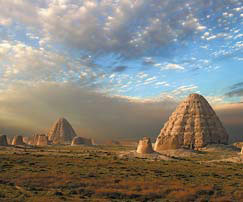Imperial tombs on track for UNESCO listing
By Du juan in Yinchuan and Wang Huazhong in Beijing (China Daily) Updated: 2015-09-09 08:05"We are confident that the Western Xia Imperial Tombs will get onto the UNESCO World Heritage list in 2018 as the local authority has been working hard to get ready for approval," said Ma Shenglin, deputy director of the administrative office of the scenic spot.
The tombs are located on the eastern slopes of the Helan Mountains in a suburb about 35 kilometers away from Yinchuan in Ningxia Hui autonomous region. According to the local authority, they are the best-preserved historic cultural heritage item representing the Tangut civilization on the largest scale and of the highest rank.
|
The Western Xia Imperial Tombs near Yinchuan are expected to be listed as a UNESCO World Heritage site in 2018. Wu Heng / for China Daily |
"There are more than 40 projects in the country competing for one opportunity to be reviewed every year by UNESCO as a world heritage site," Ma said. "The Western Xia Imperial Tombs will apply for this spot in 2018."
During the preparations the local authority has gained rich experience, Ma said.
"We have been learning from other successful cases such as many scenic spots in Beijing, as well as Shanxi, Shaanxi and Henan provinces."
The ultimate goal is not just "to be listed as a name", he said.
"We hope we can show the great ancient culture and tradition to the public, especially people from other countries. Meanwhile, it should be beneficial to the locals in terms of environmental improvement such as convenient roads and infrastructures."
The tombs are the royal mausoleums of emperors in the Western Xia Dynasty (1038-1227).
They were built between the 11th and 13th centuries, occupying an area of about 50 square kilometers.
The Western Xia Imperial Tombs include nine imperial mausoleums, 254 subordinate tombs, one large architectural complex and more than 10 brick-and-tile kiln sites.
Ma said the area's special history will attract more foreign tourists to come and explore.
As a prospective world heritage site, the tombs are described as a representative of "excellent adaptability and outstanding cultural diversity" on UNESCO's website.
The general layout of the tombs imitates the imperial mausoleum construction of the Northern Song Dynasty (960-1127). In terms of site selection, layout, burial methods, building techniques and artworks, the builders not only learned from the ritual system and cultural achievements of the Northern Song Dynasty but also combined their own ethnic customs, such as mountain worship, belief in necromancy and aesthetic orientations, reflecting the strong characteristics of the Tangut civilization's inclusiveness and cultural fusion.
The spot will attract even more tourists once it is listed by UNESCO, Ma said.
According to official data, the tombs welcome 500,000 visitors each year.
"It will be at least doubled if it is listed as a world heritage," Ma said. "The increasing visitors will not only learn a lot from the attraction, they will also bring tourism consumption, which will be good for local economic growth."
Contact the writers through dujuan@chinadaily.com.cn
- Dalian's Jinpu New District helps entrepreneurs realize dreams
- Investment, trade, tourism boom in Dalian
- Collaborations for global good
- Precision medicine promises new age of healthcare
- China's opportunity to reinforce a sustainable tomorrow
- Manufacturing in China needs to get smarter, says Deloitte report
- Data will shape future energy consumption
- Alcoa charts growth plan in line with China


















